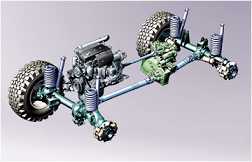Vehicle Vibration Analysis and Compensation

| Team: | M.Sc Simon Eicke |
| Year: | 2011 |
| Funding: | IAV GmbH |
Vehicle Vibration Analysis and Compensation
A current project at imes is dealing with vehicle oscillations in automobiles. The research plan aims to find and analyze causes of vibration in the vehicle, in order to take appropriate measures – control strategies – to reduce or avoid vibrations
Details
Due to the desire of an environmentally friendly driving, the mass of powertrain elements is reduced. Combined with the ability of modern engines to generate abrupt engine torque changes, this leads to the problem of driveline oscillations, known as ’driveline jerking’ or ’bonanza effect’. To avoid this unpleasant effect, controllers are implemented in the electronic control unit (ECU) of the vehicle. Although the number of functions to be optimized in the ECU is ever increasing, the automotive companies are striving to decrease test and development costs. Therefore time consuming driving tests during application are no longer practical. To overcome this problem new model based controllers can help.
By developing and identifying powertrain and vehicle models the driveline oscillations are mapped and analyzed in simulations. A special focus is set on modeling nonlinear powertrain elements like hydrodynamic torque converters and double-mass flywheels. Based on these models, innovative model predictive control strategies are developed.
